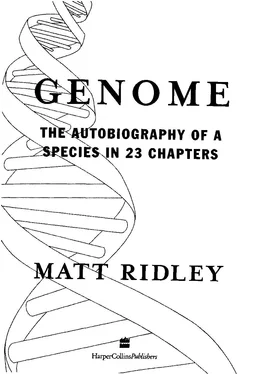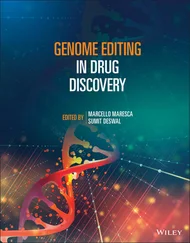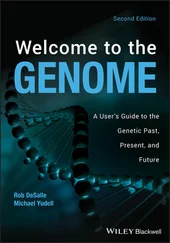Genome - Matt Ridley
Здесь есть возможность читать онлайн «Genome - Matt Ridley» — ознакомительный отрывок электронной книги совершенно бесплатно, а после прочтения отрывка купить полную версию. В некоторых случаях можно слушать аудио, скачать через торрент в формате fb2 и присутствует краткое содержание. Жанр: Старинная литература, на английском языке. Описание произведения, (предисловие) а так же отзывы посетителей доступны на портале библиотеки ЛибКат.
- Название:Matt Ridley
- Автор:
- Жанр:
- Год:неизвестен
- ISBN:нет данных
- Рейтинг книги:5 / 5. Голосов: 1
-
Избранное:Добавить в избранное
- Отзывы:
-
Ваша оценка:
- 100
- 1
- 2
- 3
- 4
- 5
Matt Ridley: краткое содержание, описание и аннотация
Предлагаем к чтению аннотацию, описание, краткое содержание или предисловие (зависит от того, что написал сам автор книги «Matt Ridley»). Если вы не нашли необходимую информацию о книге — напишите в комментариях, мы постараемся отыскать её.
Matt Ridley — читать онлайн ознакомительный отрывок
Ниже представлен текст книги, разбитый по страницам. Система сохранения места последней прочитанной страницы, позволяет с удобством читать онлайн бесплатно книгу «Matt Ridley», без необходимости каждый раз заново искать на чём Вы остановились. Поставьте закладку, и сможете в любой момент перейти на страницу, на которой закончили чтение.
Интервал:
Закладка:
On average, by the age of two, a male reindeer has three times as many warble-fly nodules in its skin as a female reindeer, yet castrated males have the same number as females. A similar pattern can be found for many infectious parasites, including, for instance, the protozoan that causes Chagas' disease, the affliction widely believed to explain Charles Darwin's chronic illnesses. Darwin was bitten by the bug that carries Chagas' disease while travelling in Chile and some of his later symptoms fit the disease. If Darwin had been a woman, he might have spent less time feeling sorry for himself.
Yet it is to Darwin that we must turn for enlightenment here.
The fact that testosterone suppresses immune function has been 1 5 8 G E N O M E
seized upon by a cousin of natural selection known as sexual selection and ingeniously exploited. In Darwin's second book on evolution, The descent of man, he put forward the notion that, just as a pigeon breeder can breed pigeons, so a female can breed males. By consistently choosing which males to mate with over many generations, female animals can alter the shape, colour, size or song of males of their species. Indeed, as I described in the chapter on chromosomes X and Y, Darwin suggested that this is exactly what has happened in the case of peacocks. It was not until a century later, in the 1970s and 1980s, that a series of theoretical and experimental studies demonstrated that Darwin was right, and that the tails, plumes, antlers, songs and size of male animals are bred into them by consistent trends of passive or active female choice, generation after generation.
But why? What conceivable benefit can a female derive from picking a male with a long tail or a loud song? Two favourite ideas have dominated the debate, the first being that the female must follow the prevailing fashion lest she have sons that are not themselves attractive to females who follow the prevailing fashion. The second idea, and the one that I propose to consider here, is that the quality of the male's ornament reflects the quality of his genes in some way. In particular, it reflects the quality of his resistance to prevailing infections. He is saying to all who would listen: see how strong I am; I can grow a great tail or sing a great song, because I am not debilitated by malaria, nor infected with worms. And the fact that testosterone suppresses the immune system is actually the greatest possible help in making this an honest message. For the quality of his ornaments depends on the level of testosterone in his blood: the more testosterone he has, the more colourful, large, songful or aggressive he will be. If he can grow a great tail despite lowering his immune defences, yet not catch disease, he must be impressive genetically. It is almost as if the immune system obscures the genes; testosterone parts the veil and allows the female to see directly into the genes.6
This theory is known as the immunocompetence handicap and S T R E S S 159
it depends upon the immune-suppressive effects of testosterone being unavoidable. A male cannot get round the handicap by raising his testosterone levels and not suppressing his immune system. If such a male existed, he would surely be a great success and would leave many offspring behind, because he could grow a long tail with (literally) immunity. Hence, the theory implies that the link between steroids and immune suppression is as fixed, inevitable and important as any in biology.
But this is even more puzzling. Nobody has a good explanation for the link in the first place, let alone its inevitability. Why should bodies be designed so that their immune systems are depressed by steroid hormones? It means that whenever you are stressed by a life event, you become more vulnerable to infection, cancer and heart disease. That is kicking you when you are down. It means that whenever an animal raises its testosterone level to fight its rivals for mates or to enhance its display, it becomes more vulnerable to infection, cancer and heart disease. Why?
Various scientists have struggled with this conundrum, but to little effect. Paul Martin, in his book on psychoneuroimmunology called The sickening mind, discusses two possible explanations and rejects them both. First is the notion that it is all a mistake, and that the links between the immune system and the stress response are accidental by-products of the way some other systems have to be designed. As Martin points out, this is a deeply unsatisfactory explanation for a system full of complex neural and chemical links.
Very, very few parts of the body are accidental, vestigial or func¬
tionless, especially not complex parts. Natural selection would ruthlessly cull links that suppress the immune response if they had no function.
The second explanation, that modern life produces prolonged and unnatural stresses and that in an ancient environment such stresses would have been much shorter-lived, is equally disappointing. Baboons and peacocks live in a state of nature, yet they too - and virtually every other bird and mammal on the planet -
suffer from immune suppression by steroids.
l6o G E N O M E
Martin admits to bafflement. He cannot explain the fact that stress inevitably depresses the immune system. Nor can I. Perhaps, as Michael Davies has suggested, the depression is designed to save energy in times of semi-starvation, a common form of stress before the modern era. Or perhaps the response to Cortisol is a side-effect of the response to testosterone (they are very similar chemicals) and the response to testosterone is deliberately engineered into males by the genes of females the better to sort the fitter — that is more disease resistant - males from the less fit. In other words, the link may be the product of a kind of sexual antagonism like the one discussed in the chapter on chromosomes X and Y. I don't find this explanation convincing, so I challenge you to find a better one.
C H R O M O S O M E 1 1
P e r s o n a l i t y
A man's character is his fate.
Heraditus
The tension between universal characteristics of the human race and particular features of individuals is what the genome is all about.
Somehow the genome is responsible for both the things we share with other people and the things we experience uniquely in ourselves.
We all experience stress; we all experience the elevated Cortisol that goes with it; we all suffer from the immune-suppressive effects thereof. We all have genes switched on and off by external events in this way. But each of us is unique, too. Some people are phlegmatic, some highly strung. Some are anxious, others risk-seeking. Some are confident, others shy. Some are quiet, others loquacious. We call these differences personality, a word that means more than just character.
It means the innate and individual element in character.
To seek out the genes that influence personality, it is time to move from the hormones of the body to the chemicals of the mind
- though the distinction is by no means a hard-and-fast one. On the short arm of chromosome 11, there lies a gene called D4DR.
1 6 2 G E N O M E
It is the recipe for a protein called a dopamine receptor, and it is switched on in cells of certain parts of the brain but not in others.
Its job is to stick out of the membrane of a neuron at the junction with another neuron (known as a synapse), ready to latch on to a small chemical called dopamine. Dopamine is a neurotransmitter, released from the tips of other neurons by an electrical signal. When the dopamine receptor encounters dopamine, it causes its own neuron to discharge an electrical signal of its own. That is the way the brain works: electrical signals that cause chemical signals that cause electrical signals. By using at least fifty different chemical signals, the brain can carry on many different conversations at once: each neurotransmitter stimulates a different set of cells or alters their sensitivity to different chemical messengers. It is misleading to think of a brain as a computer for many reasons, but one of the most obvious is that an electrical switch in a computer is just an electrical switch. A synapse in a brain is an electrical switch embedded in a chemical reactor of great sensitivity.
Читать дальшеИнтервал:
Закладка:
Похожие книги на «Matt Ridley»
Представляем Вашему вниманию похожие книги на «Matt Ridley» списком для выбора. Мы отобрали схожую по названию и смыслу литературу в надежде предоставить читателям больше вариантов отыскать новые, интересные, ещё непрочитанные произведения.
Обсуждение, отзывы о книге «Matt Ridley» и просто собственные мнения читателей. Оставьте ваши комментарии, напишите, что Вы думаете о произведении, его смысле или главных героях. Укажите что конкретно понравилось, а что нет, и почему Вы так считаете.












